Sam Nieswizski, skating historian
Sam is a skate lover. At 86, his energy is still there. And when he starts talking about skating, his eyes light up instantly. The man is passionate, fascinating, voluble, a living encyclopedia of the history of skating. Interview...
Par alfathor
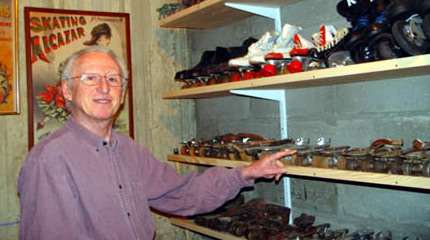
Technical facts
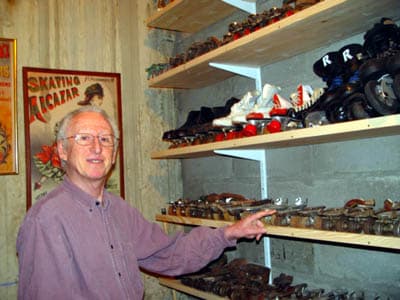 Name : Sam
Name : Sam
Surname : Nieswizski
Nickname : ‘Fend la bise’ (~’Lighning Runner’)
Job : Retired, former technician at Radio France
Birthdate : 1927
Age : 86 (in 2013)
Foot size : 42 EU
Weight : 73 kg
Height : 1.75 m
Marital status : Widower
Practice : Ice and roller skating since teenagehood
Beginning : As a child
Best dish : Herring (Russian grand parents)
Best music : Classic (Bach) and Jazz
Hobbies : Home improvement (electricity)
Likes : Skating in general
Dislikes : People who take themselves seriously and narrow ideas.
Particular signs : Skating historian. Already owned more than 4.000 items relative to the history of skating in 1991. And still keeps on gathering new ones each day.
Reference publication : Rollermania, 1991.
Once upon a time…
In the heart on Paris, not far from Place d’Italie, there lived a man whose cellar and appartment overflew with a million and one wonders (a bit more, litteraly speaking). Each corner, each cupboard holds objects with strange and outdated shapes, old wooden skates with two, three or four wheels, skates with pneumatic, metal, wooden, ivory wheels… Through those rare items, two centuries of skating look down on us. For 25 years, Sam has collected more than 4.000 items related to skating: patents, posters, postcards, books, etc. Interview…
Hello Sam, how did you become a skate lover?
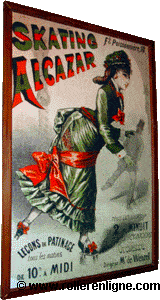 At first, I used to rollerskate just like any other kid, it was before World War II. During the Occupation, I was a teenager in the South of France, there was no more skating. Then I went back to Paris and I discovered ice skating, it was my greatest passion. I would spent all my free time there, going to the rink three times a week. But in the summertime, there was no ice.
At first, I used to rollerskate just like any other kid, it was before World War II. During the Occupation, I was a teenager in the South of France, there was no more skating. Then I went back to Paris and I discovered ice skating, it was my greatest passion. I would spent all my free time there, going to the rink three times a week. But in the summertime, there was no ice.
One day, I saw a young couple in the streets with a very sophisticated pair of skates hanging on their shoulders and I felt the need to try. They were going to the rollerskate rink. It was not the same people attending. The atmosphere was more popular, more thug minded. I was not really welcomed with open arms as I was skating with a proper ice skating outfit, a bit snobbish, with a tie, and the tough guys would often say ‘Man, that’s one mug you’ve got there for a skater ! (laughs)’.
There were the sportsmen who came and train, the tough guys who wanted to fight, and American soldiers who felt a bit like home. At that time, we practiced ‘Roller-Catch’. Every hour for 5 minutes, there was a kind of race where everything was allowed: shoulder hits, bullying, it was pretty brutal.
For me, skating was just a replacement sport back then. In 1957 I think, the roller-rink closed. It was a real kids sport. Grown-up skaters were considered like half-wits or dropouts. A few sportsmen would practice in a vacuum. The rare grow-ups who would skate for leisure asked for a place to skate, the current Palais de Tokyo, now appreciated by skateboarders.
An old man would come with a gramophone and start dancing with an imaginary partner to waltzes or military marches. People would admiringly stare at him, gaping. I went skating there for a long time.
In 1979, there was the boom of the polyurethane wheels, people would come with skates fixed on their sneakers. People would go to the Trocadero, at the Museum of Modern Art. Each year there was a street skate: ‘Paris sur Roulettes’ (Paris on Wheels). Before that period, good skates were not commercially available. Before, you would buy the best junior skates, saw the straps, drill holes in the plates and the shoes, and put wooden wheels to replace the iron wheels. There were more maintenance hours than actual use hours. From that boom on, we started finding good Italian and French skates, and I skated more often, it had become less marginal.
What made you start your research on skating?
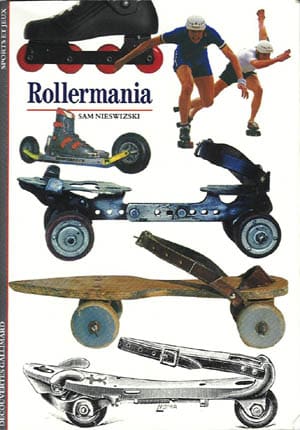 One day in the early 80’s, I came upon a Swiss book written in French about a part of the history of skating. It aroused my curiosity but it was not sufficient to satisfy me. I wanted to know what the old skates looked like, how people used to skate. I started to do research, especially at the Museum of Arts and Crafts. There was nothing at all on skating. Then one day, I went to the INPI (the National Institute of the Industrial Property). There I found patents, it put me on several tracks, I could do exhaustive research on French, English, German, American patents. I spent weeks in dusty and dark basements. Little by little I widened my research to the practice places, the skaters, the media. I went to Switzerland and to the United States.
One day in the early 80’s, I came upon a Swiss book written in French about a part of the history of skating. It aroused my curiosity but it was not sufficient to satisfy me. I wanted to know what the old skates looked like, how people used to skate. I started to do research, especially at the Museum of Arts and Crafts. There was nothing at all on skating. Then one day, I went to the INPI (the National Institute of the Industrial Property). There I found patents, it put me on several tracks, I could do exhaustive research on French, English, German, American patents. I spent weeks in dusty and dark basements. Little by little I widened my research to the practice places, the skaters, the media. I went to Switzerland and to the United States.
Is it why you wrote Rollermania?
I had more and more notes on my research, I said to myself that there was enough content to make a book. I did not ask myself if it was editable, profitable and I did not pay attention to the commercial side. Once it was almost completed, I started knocking at editors’ doors but nobody wanted that book. It was not consistent with the editors’ logics.
During all that time, the book kept on growing. One day, I came across an ad by Galllimard: they were looking for young authors (under 25) relating an experience, an adventure, a research. I sent a letter, my manuscript was given to a manager of the ‘Discovery’ collection who accepted to edit it. They got into it right away. That book worked because it was a turnkey work, with all the iconography and the illustrations. One year was needed to adjust to the collection. The two-thirds of the book were cut. 15.000 copies of Rollermania were released and today the two-third have been sold, that is to say around 10.000 copies. There are still regular sales today.
Do you still go on with your research?
From time to time I find new documents, but the main part of my work now is transforming my notes into databases. For example, I did a database on skating and cinema, on patents, etc.
Do you know other skating historians?
Yes and no. I communicated by phone with a collector who gave his treasures to the Skating Museum of Lincoln (Nebraska, USA), but I never
Do you still skate?met him. In France, another collector has as many skates as me, he collects and restores pairs of skates. He lives close to Paris. He found his vocation in reading my book. Today, I’m limited by the space, I don’t seek to get new items.
I had a little skating accident not so long ago. While doing a simple trick, I fell doing the splits and I tore a muscle. I can walk normally again. For the moment, roller skating is in stand-by, but I resumed ice skating last week!
Which practices do you like best?
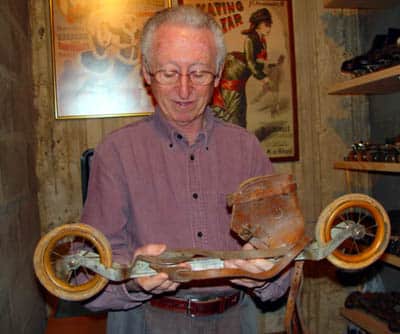 I do fitness skating from time to time, but what I like best is artistic skating, in my own scale in a delimited space. I like curves, waltz steps, relatively simple things. As soon as I learn something on ice, I try to transfer it to roller skating. For example I had a go at short-track skating without having practiced speed skating, just to get the style that I liked a lot.
I do fitness skating from time to time, but what I like best is artistic skating, in my own scale in a delimited space. I like curves, waltz steps, relatively simple things. As soon as I learn something on ice, I try to transfer it to roller skating. For example I had a go at short-track skating without having practiced speed skating, just to get the style that I liked a lot.
What does a typical day looks like?
I don’t have any rules. I never know what I will do when I wake up. I like going to the market, I like cooking. Someone takes care of the house keeping. I like reading, going to fairs, to the theater, to some concerts. I listen to music recordings. I spend my time just like somebody on holidays. Sometimes I meet journalists, they come in waves. There is a snowball effect when one of them writes an article, others come. Often they ask the same questions and I answer the same thing, it’s a bit annoying, I have the impression of becoming a parrot.
The skating trend being a bit outdated, how do you see the future of skating?
I’m not able to answer that. You always think that everything has been said and done, and another novelty pops up. For example I think that freestyle skating is getting closer to other sports such as trampoline and diving. I have nothing against that, I admire it a lot, but it’s another sport. Slalom skating fascinates me because it’s not artistic skating, but it requires as much virtuosity. I’m in admiration when I see experts.
According to you, what are the next technological evolutions?
It’s hard to foresee. You think that high standard skates have reached a technical peak, but there are still improvements going on. You realize that in fact the current innovations are often nothing but improvements of concepts of the past, of old ideas made more efficient.
For example, inline skating became performant with the arrival of polyurethane wheels. Today’s skates are fantastic. In my opinion, the paths of progress are in the artistic inline skates with rockered wheels and a toe stop. They are good but can’t be found easily in the shops and could still be improved.
Innovations have not always been well received. I remember in speed skating to have heard the public make comments when Arnaud Gicquel would win the French Championships using inline skates. Gicquel answered that we would be eternal losers if we didn’t follow the other countries.
Did the place of skating evolve in the urban landscape over the last years?
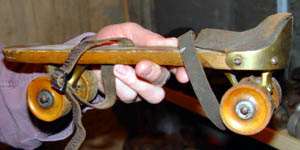
The image of skating didn’t improve a lot lately. The car drivers keep on complaining when they are stuck because of the Friday night skate. If they see a skater on the road, they fly off the handle and they sound the horn even if the skater isn’t in their way. The pedestrians tend to think that the pavement is reserved for them and that skaters shouldn’t be there. With cyclists it’s more complex, the relations are both kind and unpleasant at the same time.
The kind side: there were common street skates during which cyclist would laugh at the skaters on damaged roads, and the skaters would return the favor in case of a flat tyre. As for the unpleasant side, on a cycle lane, with two bikes side by side, they rarely move out of the way to let you go. They may be right somehow, as nothing indicates that it is allowed to skate there.
What do you think of the big damper given to the status of skating?
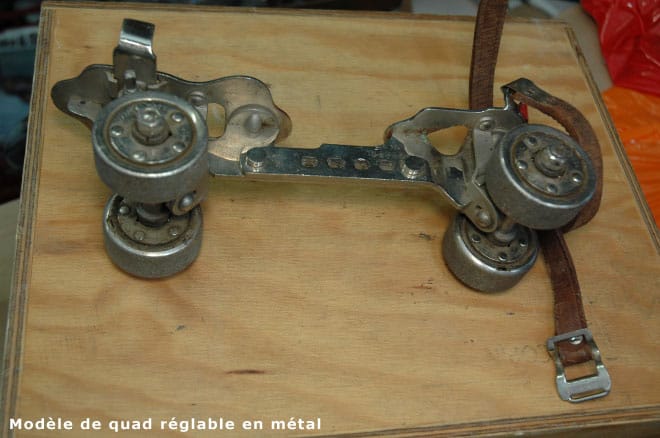 I’m very pessimistic about that. On a pavement, some skaters don’t always master their movements. Some others are at ease and show off, which may frighten the pedestrians who don’t accept us well.
I’m very pessimistic about that. On a pavement, some skaters don’t always master their movements. Some others are at ease and show off, which may frighten the pedestrians who don’t accept us well.
In the US for example, the skaters don’t show off and the pedestrians are not affraid. You feel that the skaters know what they’re doing and they keep their distances to not frighten the pedestrians. The cars tolerate the skaters. It’s all about mentality and education at first.
Legislating is complicated given that a bike will disturb a car and skates will disturb even more.
On the pavement, skaters go too fast compared to pedestrians. You can’t oblige skaters to be under 8 kph. The only practical measures that could be taken would be to widen the cycle lanes. The pendular movement of the skater needs more room than that of a clyclist.
There is the illusion from people who make reforms, when they imagine that delimited practice places will be enough for skating. Track and road skaters are not the same. It’s not a reason not to build skating places, but it doesn’t solve the problem.
Are there other points that you would like to talk about?
I’d like the federation to be more open, especially in relation to technique and technological innovations, like in artistic inline skating. Moreover, it’s a shame that the sport dimension of skating is too little broadcasted. It’s better than ten years ago but we’re not there yet. Probably that the image of a kid’s game still prevails. Today it’s a common practice. And yet, in the Equipe Magazine, it’s exceptionnal to find a few lines about skating…
Links
a
Translation: Chloé Seyres
Photos: Alfathor and all rights reserved
